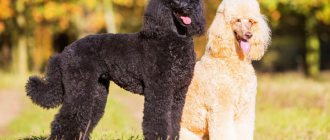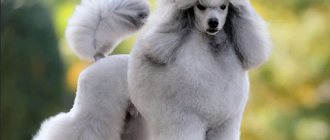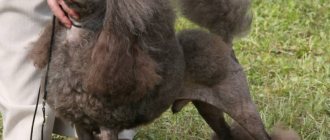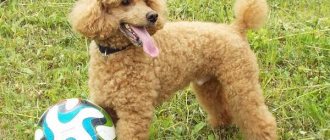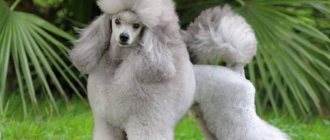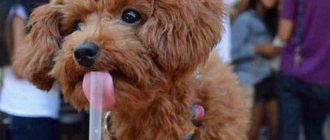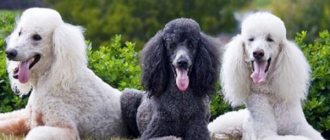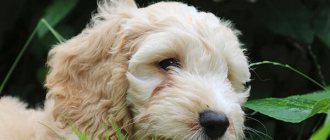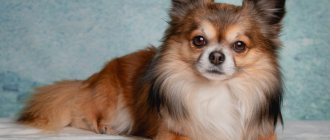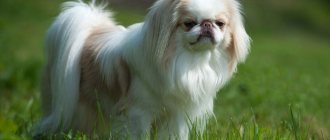Breed characteristics
| Short description | |
| Origin: | France |
| Conditions of detention: | In an apartment, private house |
| Purpose: | Decorative, companion |
| Color: | Ash, black, white, red, brown, apricot |
| Wool length: | Long (7-8 cm) |
| Adult dog size: | The height of females is up to 29 cm, males up to 36 cm, weight of males is approximately 6-7 kg, females - 4-6 kg |
| Average life expectancy: | 12-15 years |
| Walk: | Twice, daily |
| Physical activity needs: | Medium (walks from 1.5 to 3 hours a day) |
| Fédération Cynologique Internationale (FIC) classification: | Group 9: Toy and companion dogs; Section 2: poodles |
| Puppy price: | From 7 to 15 thousand rubles, without pedigree - 7-8 thousand rubles, pet class - 8-10 thousand rubles, breed class - 10-12 thousand rubles, show class - 15 thousand rubles. |
Variety
Poodles are divided into varieties based on height and weight. This also determines the purpose of the dog. Thus, large and medium poodles belong to the category of service and sports dogs. Dwarf and toy poodles are exclusively decorative.
When choosing which type of poodle to purchase, you should strictly consider whether there is an opportunity for long walks and sufficient space in the apartment. Small dogs are most convenient in city conditions. For a large poodle, keeping it in a country house is optimal.
Important! The characterization of the dwarf poodle breed as a decorative one is not accidental, and it is impossible to breed it as a smaller copy of a sporting one for the same purposes.
History of the origin of the species
The Miniature Poodle is a breed developed from the Royal Great Poodle, which gained particular popularity in the 15th and 16th centuries. Only the nobility bred such dogs; commoners were forbidden to keep curly-haired dogs.
The first paintings depicting similar animals date back to the 13th century. But the most ancient images of poodles were found on Roman tombs dating back to the 30s BC.
The breed belongs to France, although the name has German roots. Poodle, from German “ puddeln ”, means splashing in the water. Initially, dogs were used as water bird hunters; they dived into lakes for ducks and brought them to their owner. In French the breed is called Caniche and stands for " duck ".
The origin still causes controversy among dog experts. There are several opinions about the ancestors of poodles. According to the first version, their ancestors are divers and European herding dogs. But many scientists are inclined to believe that the closest relative of the curly-haired beauty is the Barbet, who also hunted waterfowl.
Miniature poodles were only developed in the 19th century. This was done by the Swiss scientist Shaitlin, who was delighted with all the qualities of the Royal dogs. By 1880, the breed was described and the first standard was established. However, breeding work continued until the 21st century.
Vaccination schedule
Puppies up to one year old will need the following vaccinations:
- 8-10 weeks is the first vaccination for a puppy against parvovirus enteritis, viral hepatitis and distemper;
- 11-13 weeks - second vaccination against parvovirus enteritis, viral hepatitis and plague. At this time, the puppy receives its first vaccination against rabies.
If the risk of contracting rabies is low, for example, the puppy does not come into contact with carriers of the virus, then vaccination can be delayed until 6-9 months.
Distinctive features
Miniature poodles fit into the general standard of poodles and differ from other species only in size. They are considered a smaller version of the average breed, not as refined and weak as the Toy Poodle.
The latest standard was published in 2007. According to it, the mass of the Dwarf representative should not exceed 6 kg and be less than 4 kg . The height at the withers varies from 28 cm to 35 cm . All individuals with inappropriate characteristics are discarded.
- The head is not very refined. The brow ridges are well defined, the stop is faintly visible, represented by a smooth line.
- The muzzle is strong and wide, rounded at the end. Long (amounts to 9/10 of the skull). Cheekbones of medium volume. The skull is not filled in under the eyes. The teeth are quite strong, with a scissor bite The lips are well developed, the thickness is average, the color depends on the color of the coat - the darker the color, the darker the pigment.
- The nose is large with well-developed nostrils, slightly upturned. The color of the nose changes with the color of the coat: in white, black and gray poodles it is black, in apricot, red and brown poodles it is most often brown.
- The eyes are set at stop level, slightly slanted. Almond shaped. The color of the iris can be black or brown.
- The ears are wide at the base, long, thin, hanging down to the sides of the head.
- The body is strong and well built. The back is straight and strong, the croup is located at the same height as the withers. The loin is short and strong. The chest is well dropped (to the middle of the elbows), wide (2/3 of the depth), the ribs are rounded. The neck is of medium length, strong, and its cross-section forms an oval. The scruff is convex , there is no dewlap. The stomach is tucked.
- The tail is set high, carried upturned, and slightly inclined. Long enough, docking is possible.
- Limbs straight , parallel. The muscular system is well developed, the knee, elbow and hock joints are visible. The feet are small, compressed, with strong black or brown claws. Moves easily and springily.
- The coat can be curly or corded. In the first case, the coat should be thick with uniform fluffy springy curls. In the second - long corded curls (at least 20 cm).
- Color: gray, white, black, peach, red and brown (solid).
What is the difference between a toy poodle and a miniature poodle?
The main difference between a toy poodle and a toy poodle is height. The height of the first is 24–28 cm, the second is 28–35 cm. Another difference that is noticeable only to experts is the degree of expression of the occipital protuberance. In a toy poodle it may be slightly different - a little less noticeable.
However, other signs of dwarfism (sharp stop, spherical skull, snub muzzle) are excluded. Otherwise, the dogs are small copies of their larger counterparts, have the same proportions and are judged to the same standard.
Photo of an adult dog
Possible diseases
Over a long period of existence, characteristic diseases have emerged in dogs. Certain genetic diseases can be passed on from parents. Therefore, when buying a puppy, it is important to see the parents of the future pet.
The following diseases are common for pets:
- Deafness.
- Retinal atrophy.
- Ear infections.
- Heart diseases.
- Diabetes.
- Autoimmune anemia.
Health disadvantages include early gray hair. Brown pets are especially susceptible to this defect. Increased tear production is possible. If this spoils the appearance of the pet and contaminates the eyelids, the corners of the eyes should be wiped with a cotton swab. The cotton wool is first dipped in boiled water.
Photos of puppies
Causes of premature death
Premature death of a dog can be caused by:
- insufficient and unbalanced nutrition;
- neglect of routine vaccination;
- lack of antiparasitic treatments;
- lack of physical activity and walking;
- untimely treatment;
- poisoning by poisons.
Important! Poodles are active dogs with an inquisitive nature. Therefore, small curious animals often die due to the carelessness of their owners. Toy poodles often find themselves crushed under furniture or doors.
Features of character and behavior
The Miniature Poodle is a good option for older people and families with children . He can adapt to any pace of life and will not impose himself on his owner. These dogs are active and cheerful, but love to sleep and spend time with people.
In terms of intelligence, poodles are second only to Border Collies, so training them will not be difficult even for a child, but only over 7 years old . They are quite sensitive to external stimuli, so you need to be careful.
Advantages
- Poodles have won the love of humans thanks to their perky disposition and excellent performance.
- They are very smart, thanks to which they can follow any commands.
- Often such dogs are used as artists and circus performers.
- Poodles are not prone to stubbornness or willfulness.
- They are friendly and playful, devoted to the family, get along well with children, and can make friends with other pets.
- They behave gracefully and elegantly in public.
- Externally original and cute.
- The security qualities of poodles are not inferior to large dogs. In case of any danger, such a pet will begin to bark loudly and protect the owner.
Flaws
- Poodles are unbalanced and have a weak nervous system . They are quite irritable and react to loud noises, strangers, and sudden movements. They bark often and for a long time, especially at a young age.
- They do not tolerate quarrels well; due to stress, pets develop problems with the digestive system.
- Very active, needs regular walking. Without the necessary physical activity, they can become uncontrollable: chew furniture, spoil things, whine loudly.
- Rarely tolerant of strangers, in some cases even aggressive . Without early socialization, the opposite effect can occur - timidity and isolation.
- Poodles cannot stand being alone . They should not be left for a long time. They constantly crave attention, care and affection.
Interesting Facts
Interesting facts, like the dog himself, are known about the funny dog:
- Poodles served in Napoleon's army. They were included in the list of mandatory equipment for officers. The function of small dogs was to attract attention. In case of injury, the owner released the baby from the backpack, and he began to bark loudly and fuss around the fighter. Thanks to this, doctors on the battlefield immediately noticed who needed help.
- The famous composer Richard Wagner took his little poodle to rehearsals. The furry “expert” always barked if one of the musicians played false notes.
- The “hairstyle” of this breed is not a fashion statement. Previously, when dogs were used for hunting, they often had to get into cold water. However, the abundance of thick wool did not allow for quality work. Therefore, the owners cut their pets, leaving hair on the most vulnerable parts of the body.
Care and maintenance
Poodles do require a lot of care. They need to devote time and invest a lot of material resources to ensure that the pet looks healthy and tidy. This dog needs careful brushing, regular haircuts, and standard hygiene procedures using special products.
A poodle can only be kept indoors; it is not suitable for the outdoors, although it easily tolerates climate changes. Before buying a puppy, you need to purchase a comfortable bed, bowls with adjustable heights, brushes and other hygiene products.
Nutrition
To prevent your dog from becoming obese, your pet needs a strict diet . These dogs love to eat heavily and will constantly beg. In addition, this breed is characterized by diseases of the digestive system, in particular the liver. Therefore, for Poodles it is important to have three components:
- Squirrels;
- Cereals (porridge, cereals);
- Vegetables and fruits.
The basis of the diet should be low-fat fermented milk products (cottage cheese, kefir), chicken, turkey and beef, raw and boiled, eggs (2-3 times a week). It is important to give your pet liquid food (broths, soups).
These dogs never get full, so you should limit your food intake to two times a day . Puppies are fed more often - 5-6 times a day . Serving size is calculated using the formula: 20% of the puppy’s weight. You should not feed your Poodle from the table; this bad habit negatively affects digestion and is very difficult to wean from it.
- The recommendations are similar when feeding dry food . You should choose only among super premium and holistic baits (grain-free). Mixing natural products and dry food is not recommended.
- During puppyhood, it is important to give your Miniature Poodle cottage cheese to strengthen bone tissue. If the puppy refuses this product, then calcium gluconate is mixed into the food. The vitamin complex is prescribed by a veterinarian and should not be neglected.
It is important to monitor what your pet picks up on the street. Household items, garbage and branches can be infected with the virus or made from low-quality materials. The dog may eat small parts or contract an infection.
Health
Poodles are not in good health, especially toy and dwarf ones. They are predisposed to many genetic diseases associated with the digestive, musculoskeletal and other organ systems. The mucous membranes, ears and noses of dogs are especially susceptible to bacteria and must be carefully monitored.
Even with careful selection of a puppy, the likelihood of acquiring a completely healthy friend is low. Many diseases appear already when the pet becomes an adult. However, with proper care and compliance with all vaccination rules, there is a chance to extend the life of a poodle. Average life expectancy is 10-15 years.
Vaccinations
Vaccination is carried out in designated places - veterinary centers and clinics under the guidance of experienced specialists. You cannot do vaccinations yourself. The price of the medicine varies from 450 to 1500 rubles, depending on the drug and its purpose.
There are two main vaccines accepted for dogs:
- Complex vaccination against enteritis, leptospirosis, plague, influenza, salmonellosis, hepatitis. The first one is done at 1.5-2 months, and repeated after 2-4 weeks. Then at 6 and 12 months, and then annually.
- Rabies vaccination (required for export abroad). Vaccination is carried out at 6-7 months and is updated annually.
Before vaccination, the pet undergoes a deworming procedure (getting rid of internal parasites, worms) using special tablets. After vaccination, the dog must be incubated for 2 weeks to establish immunity (you cannot walk or bathe it).
Diseases
Most often, breed diseases of poodles relate to problems with digestion (diabetes, obesity, volvulus, indigestion, allergies) and with mucous membranes (deafness, conjunctivitis, lacrimation, otitis media). In addition, these dogs are prone to a number of diseases:
- Epilepsy;
- Hip dysplasia (due to excessive load on the hind limbs, incurable, manifests itself in the form of acute pain and lameness);
- Displacement of vertebral discs;
- Oncology;
- Anemia.
Walk
- Although a poodle is considered a domestic decorative dog, it is necessary to walk with it 2 times a day (1 hour each).
- These dogs love to run and play ; physical activity contributes to the proper formation of the skeleton. Swimming in a pond would be a good workout.
- The dog must be walked both on a leash and without it. Puppies are walked more often (3-4 times a day) , but for 15-20 minutes . Do not put intense physical activity on the hind legs (jumping, going down stairs).
- Early socialization and meeting other pets is an important point in developing a dog’s emotional stability. If there is insufficient communication with unfamiliar people and animals, the puppy will become fearful or aggressive.
- In winter, it is recommended to walk poodles in a protective suit, and in summer, avoid direct sunlight and take a bottle of water with you.
Grooming
Poodles do not shed or emit unpleasant odors, they are considered hypoallergenic, but their coat requires serious care.
- Such a pet needs to be combed 3-4 times a week with a stiff brush with thick teeth. Every 5-6 weeks , Miniature Poodles are groomed; you can do this yourself if you learn how to use a furminator and scissors.
- These dogs are bathed once every 5-7 days using special shampoos and conditioners. Then the pet needs to be dried with a hairdryer and combed. After a walk, you need to wash your paws under warm water and remove debris from the strands.
- The vulnerable spot of poodles is their ears; bacteria and excess wax deposits accumulate in them. Therefore, ear cleaning should be done at least 2 times a week . The eyes are examined and wiped clean of tears daily.
In the summer, you need to treat your pet for fleas and ticks, and make sure that the dog is not exposed to direct sunlight. During winter and dirty weather, poodles wear protective overalls.
Nutrition
Poodles are real gobblers. They behave as intrusively as possible when they see food in the hands of household members or their guests. They can make the cutest face in order to beg for a piece. Remember, you cannot feed purebred dogs from your table! Their stomach is not able to digest every product.
Miniature Poodle puppies should eat:
- Lean meat (turkey, veal, beef, chicken).
- Lean fish. It is important to clean it before giving it to your dog.
- Chicken eggs.
- Boiled porridge.
- Soups.
- Kefir or milk.
- Hard cheese and cottage cheese.
In addition to water, they should drink milk. You can boil it first. Your pets should always have access to clean drinking water. At 6 months of age, the baby can be gradually transferred to another product - wet or dry food. We recommend adding a small amount of the product to a bowl of porridge or soup. This will allow you to quickly get used to the change in diet.
Mating
Breeding a dog is a responsible task and not every breeder can cope with it. They often resort to the help of specialists, especially when “untying” a pet. Puberty in a male Miniature Poodle occurs in the second year of life, in a female a little earlier - 20 months. At this time, the girl should already be in her third heat. Dogs can be brought together on the 11th-15th day of estrus, this is signaled by the female’s low temperature.
First of all, you need to choose a male dog. Not all pets will accept each other; for this they need time. Usually they are simply walked together before mating. Afterwards the dogs are taken to the boy's territory.
The owner must actively help the dogs. Due to his short stature, it is difficult for the male to get into the vagina. The breeder needs not only to hold the pets, but also to guide them. After a successful “lock”, the animals are still held for some time (about 40 minutes).
Mating must be repeated after 2 days, and in the sixth week the pregnancy must be checked at an ultrasound center.
List of suitable nicknames
Choosing a name is the first step after purchasing a poodle. It is important to find an option that the family will like, will be easy for the pet to remember and will be easy to pronounce.
Nicknames for male toy poodles:
- Cupid, Agate, Archie, Bucks;
- Baron (Barry), Barney, Bim, Bike;
- Bolt, Willy, Chip;
- Chief, Chuck, Butch;
- Oscar, Fluff, Arnie, Claude;
- Woody, Scooby, Bond;
- Pirate, Toby, Cliff, Earl, Gray, Horus;
- Harold, Casper, Tom;
- Kurt, Rich, Luke;
- Peach, Kai, Hans;
- Henry, Kazbek, Eric, Olympus;
- Perce, Jerry, Simba, Pike;
- Donald, Motya, Zeus;
- Hulk, Timon, Sonic;
- Charlie, Walt, Leo;
- King, Nike, Larry;
- Bim, Dick, Chase, Simba.
Nicknames for female miniature poodles:
- Astra, Alpha, Gina, Bella, Bonnie;
- Jesse, Dina, Debi, Tori, Molly;
- Vesta, Chapa, Dusya;
- Gerda, Greta, Gabi, Hera;
- Ella, Emma, Zita;
- Kira, Nancy, Paw, Knopa;
- Dana, Lily, Remy, Laura, Gucci;
- Zlata, Mila, Maya;
- Irma, Salma, Doll, Tosya;
- Uma, Jody, Motya (Matilda);
- Sandra, Taya, Tina;
- Vika, Viva, Tonya, Shura.
Owners often name their pets not by the character of the dog or its breed, but by the names of animals from pleasant childhood memories or by the names of places they once visited.
Key points in training
Toy poodles are intelligent and easy to train. It is enough for them to understand what the owner wants from them. Therefore, crude methods are not needed. You need to raise a puppy from the first minutes of his stay in the house. The dog must know its daily routine and rules of conduct with its owner. The puppy should also be accustomed to regular walks on a leash.
Poodles do well in agility (obstacle courses) and show programs. They need constant mental stimulation, so training should be done in a playful way and constantly add something new.
Read about how to properly train a dog in the article: “Training a puppy: effective methods from dog handlers, learning commands at home.”
Owner reviews
We recently acquired a toy poodle named Persian. We chose this breed because we wanted a beautiful small dog. We don’t regret the purchase: the dog devotedly loves the whole family, adores the cat and is indifferent to strangers (that is, he does not fawn over strangers, but does not show strong aggression either). The breed lives well in a 2-room apartment.
This dog is very smart, but mischievous and cunning. I had to struggle during the training, but the result was good. Among the shortcomings of the poodle, I would like to note its noise (ours loves to bark when the opportunity arises), grooming (but this is a matter of habit) and mobility - unlike us, she never gets tired! I recommend the breed to active and not lazy people.
Among the big advantages of our dwarf poodle Kesha are his cheerful character and small size. The downside is that the puppy is rather stupid and aggressive outside the norm. Runs after cars, dogs, cats. Often growls at passersby. Therefore, we walk him strictly on a leash. But on average, it’s an ordinary dog, with its own character and habits.
The popularity of the breed is explained solely by the decorative appearance and high intelligence of the dogs. However, every owner will confirm that this pet has many more advantages: miniature poodles are very kind, cheerful, loving and devoted friends. But it is recommended to have such a dog only if the owner is willing to devote a lot of time and effort to it.
How to choose a puppy
Poodles can be purchased anywhere in the world; it is advisable to do this from an official breeder who can guarantee the health and pedigree of the puppy. A good nursery will provide you with the necessary documents (a veterinary passport in particular) and tell you about the living conditions of the dogs. If possible, you should look at the poodle's parents.
Puppies must be fully compliant, playful and clean. Their cost depends entirely on the external characteristics and status of the parents. Without a pedigree, a poodle puppy can be purchased for 7,000 rubles, but for a show-class dog you will have to pay 15,000 rubles.
Miniature poodles are an ideal option for family people who like to spend time surrounded by loved ones. These dogs will accompany their owners everywhere, without imposing their attention.
4.6 / 5 ( 18 votes)
The most popular haircuts
A haircut is required every 2 months at home or in a salon.
- A lion. The fur is cut on the back of the body to the ribs, as well as the paws, muzzle and tail. Pompoms remain at the ankles and the tip of the tail.
- Modern. With a modern haircut, the hair in the area of the muzzle, back and croup is removed, the belly and sides are trimmed to a length of 1 cm.
- Bikini. The bikini cut involves short hair all over the body, with pompoms remaining at the ankles and tail.
Signs of aging
You can determine that a dog is no longer young by the following signs:
- decreased dog activity;
- manifestation of chronic diseases;
- abrasion and loss of teeth;
- the appearance of gray hair;
- change in gait;
- deterioration of the coat condition.
Depending on the type of breed, poodles live from 13 to 18 years. But with proper feeding, quality veterinary care, good care and attention, the dog will please its owners much longer than the average.
